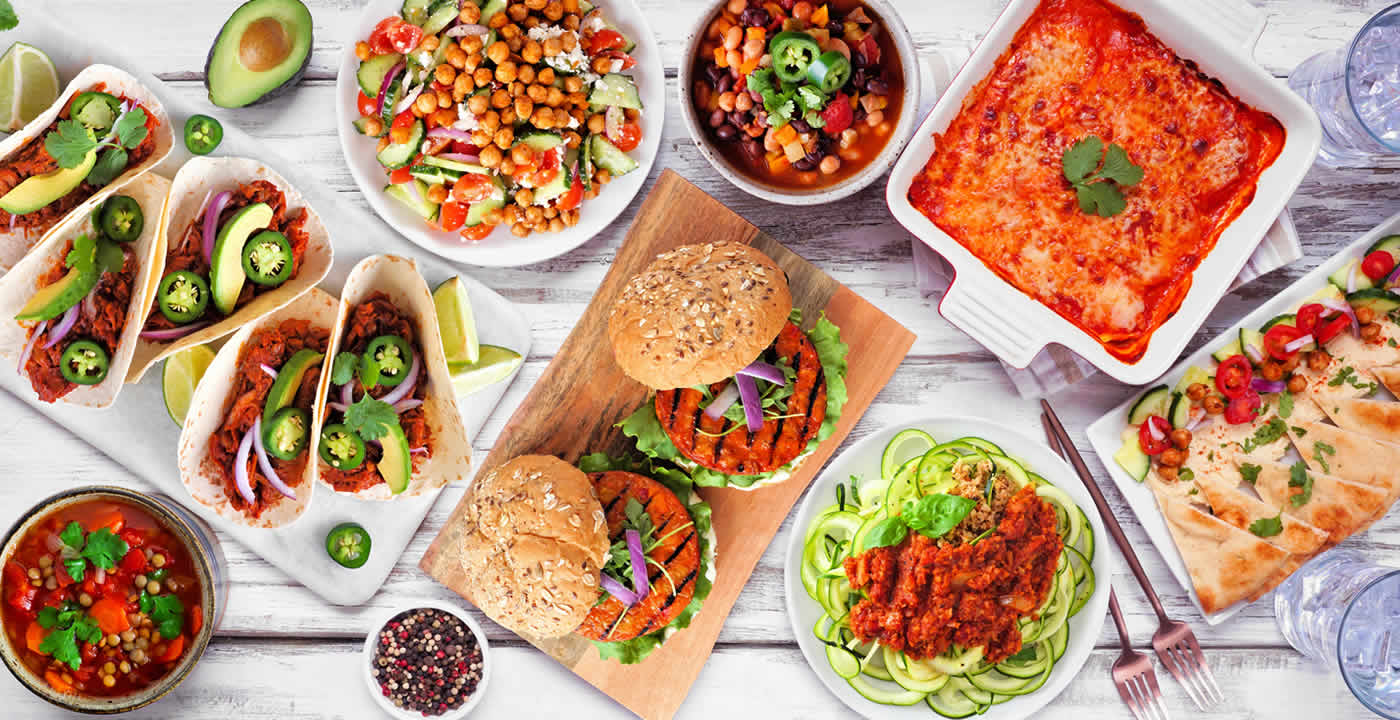Picture this: a gooey, melting cheese pizza, rich chocolate cake, or that hearty, filling lasagna that feels like a warm hug. Comfort foods strike a nostalgic chord that satiate not just our palate but also our souls. However, these delicious dishes often have a not-so-comforting effect on our waistlines (or our health). What if we told you that you can still enjoy these flavorsome delights, but with a healthy, plant-based spin?
Welcome to our journey of reinventing comfort food! This blog is for all the health-conscious food lovers out there who refuse to compromise on flavor. Join us as we transform classic dishes, making them lighter, packed with nutrients, and entirely plant-based. We'll discuss the rise of plant-based eating and its potential health benefits. Then, we'll introduce you to some classic dishes, reimagined with a healthy, plant-based twist. From delectable entrees to lip-smacking desserts, we have you covered!
The Importance of Comfort Food

When we think about food, it's not just about nutrition or sustenance. It's also about connection, tradition, memory, and comfort. Comfort food, the term itself, evokes a sense of warmth, safety, and well-being. It's closely tied to our emotions and carries a significant cultural weight that stretches across regional bounds.
Therefore, while we value and enjoy comfort foods for their emotional comfort and cultural significance, it's essential to acknowledge that these benefits often come at a cost to overall health. Time to reinvent comfort food! It’s time to create versions that maintain the emotional and cultural connections while aligning with healthier, plant-based recipes. By doing so, we can ensure that these beloved dishes continue to provide comfort, without compromising our health or ethical beliefs.
The Rise of Health Conscious and Plant-Based Eating
In recent years, the world has seen an extraordinary shift towards health-conscious and plant-based eating. This change is not a fleeting trend but rather a substantial movement driven by a greater understanding of nutrition and its role in our overall health.
 Surge in Health Conscious and Plant-Based Diets: A Statistical View
Surge in Health Conscious and Plant-Based Diets: A Statistical View
Health Benefits of Plant-Based Eating

Transitioning to a plant-based diet comes with a multitude of health benefits:
- Nutrient Rich: Plant-based diets tend to be high in fiber, antioxidants, and various other nutrients. Fruits, vegetables, whole grains, and legumes, staples of a plant-based diet, are packed with vitamins and minerals essential for optimal health.
- Heart Health: A plant-based diet can contribute to lower cholesterol, blood pressure, and blood sugar, all of which can decrease the risk of heart disease.
- Weight Management: Due to the high fiber content and lower fat levels in plant-based foods, these diets can help maintain a healthy weight and prevent obesity.
- Disease Prevention: Several studies have linked plant-based diets with a reduced risk of chronic diseases, including cancer, type 2 diabetes, and heart disease.
This rise in health-conscious and plant-based eating, though revolutionary, is a promising trend towards a healthier, more sustainable future. It signifies a collective effort to align our food choices with the needs of our bodies and the planet, creating a better balance for all.
Challenges in Reinventing Comfort Food
Recreating comfort food in a healthier, plant-based fashion is an exciting culinary journey. However, it's not without its fair share of challenges. From

maintaining the taste and texture that make these dishes so beloved, to ensuring they are still nutritionally balanced, there are several considerations to be made.
Understanding Plant-Based Ingredients
Adopting a plant-based diet doesn't mean you have to say goodbye to your favorite dishes. Instead, it opens up a world of exciting new ingredients that can serve as substitutes, allowing you to recreate beloved recipes in a healthier, plant-based way.
Let's explore some of these transformative ingredients, their health benefits, and how they can be used in cooking.

1. Nutritional Yeast

2. Tofu and Tempeh

3. Legumes

4. Plant-Based Milks

5. Flaxseeds and Chia Seeds
These are just a few examples of the wonderful plant-based ingredients that by understanding these ingredients and how to use them, you can not only recreate your favorite comfort foods but also discover new flavors and dishes that you love.
Recipe Re-inventions: Healthier, Plant-Based Twists on Classic Comfort Food Dishes
Turning classic comfort foods into healthier, plant-based alternatives is an exciting culinary adventure. Here, we will explore some of your favorite dishes and how they can be reinvented to fit a more health-conscious, plant-based lifestyle. We will dive into the categories of entrees, sides, and desserts.
Example entrees

1. Vegan Spaghetti Bolognese
The traditional Bolognese sauce, filled with ground meat, is replaced in this recipe with a savory lentil and mushroom mixture that's just as hearty and satisfying.
Key Plant-Based Ingredients: Lentils, mushrooms, whole grain pasta, tomatoes.

2. Plant-Based Meatloaf
This classic comfort food is traditionally packed with ground beef, but a plant-based version can be made with a mix of lentils, chickpeas, and plenty of flavorful spices. Glaze it with a sweet and tangy tomato sauce for a familiar finishing touch.
Key Plant-Based Ingredients: Lentils, chickpeas, flaxseeds, whole grain bread crumbs, tomato sauce.
Example sides

1. Vegan Garlic Mashed Potatoes
Classic mashed potatoes often contain milk and butter, but these vegan garlic mashed potatoes are made creamy and flavorful with almond milk and a touch of olive oil.
Key Plant-Based Ingredients: Potatoes, almond milk, olive oil, garlic.

2. Plant-Based Creamed Spinach
Creamed spinach, a beloved side, typically contains cream and cheese. Our version uses a cashew cream and nutritional yeast to give you a rich, creamy, and dairy-free side dish.
Key Plant-Based Ingredients: Spinach, cashews, nutritional yeast, garlic.
Desserts
-
Vegan Apple Pie

Using a dairy-free butter alternative for the crust and a dash of coconut cream in the filling, this apple pie will satisfy your dessert craving in a healthier, plant-based way.
Key Plant-Based Ingredients: Apples, whole grain flour, dairy-free butter, coconut cream.
-
Plant-Based Chocolate Pudding

This chocolate pudding is made creamy and rich with avocados and sweetened naturally with ripe bananas and a touch of maple syrup. Top with fresh berries for an added burst of flavor.
Key Plant-Based Ingredients: Avocados, bananas, cocoa powder, maple syrup.
Whether you're new to plant-based eating or looking to expand your recipe repertoire, these reinventions of classic comfort foods provide a great starting point. As you grow comfortable with these, feel free to branch out, explore, and let your creativity run wild. The possibilities in plant-based cooking are endless!
Tips to reinvent your favorite classic comfort food

Reinventing classic comfort food into healthier, plant-based versions can be a rewarding journey. If you're ready to give your favorite dishes a plant-based makeover, here are some practical tips to set you up for success.
- Start with Familiar Recipes
When starting, choose a familiar recipe that you love and know well. This will give you a good sense of the flavor profile and textures you're aiming for in the plant-based version.
- Understand Your Ingredients
A key part of successful recipe reinvention is understanding how to use plant-based ingredients. Each ingredient has unique properties and knowing how they behave can help you substitute effectively. For example, tofu can take on the flavor of its marinade, while beans and lentils can provide a meaty texture in dishes.
- Focus on Flavor
It's essential to keep your dishes flavor-packed. Spices, herbs, and condiments are your friends when cooking plant-based foods. They can help elevate your dishes, making them just as satisfying, if not more so, than the originals.
- Embrace Whole Foods
While there are plenty of processed plant-based foods on the market that can mimic meat or dairy products, focusing on whole foods like vegetables, grains, and legumes will generally result in healthier dishes.
- Master Plant-Based Protein Sources
Getting enough protein in plant-based dishes can sometimes be a challenge. Master cooking with a variety of plant-based protein sources such as legumes, tofu, tempeh, and seitan.
- Don't Forget the Texture
Texture plays a significant role in our eating experience. When reinventing recipes, pay attention to the textures in the original dish and try to replicate those as much as possible. Whether it's the crunch of a crust, the creaminess of a sauce, or the chewiness of meat, there's usually a plant-based way to mimic it.
- Experiment and Have Fun
Finally, don't be afraid to experiment. Not every attempt will be a home run, but that's part of the process. With every dish you make, you'll learn more about cooking with plant-based ingredients and get better at it. The key is to have fun and enjoy the process of creating healthier versions of your favorite dishes.
Remember, moving towards a plant-based diet doesn't mean giving up on the foods you love. It's about finding new ways to enjoy them that align with your healthier lifestyle choices. Happy cooking!
Finding new flavors with plant-based comfort foods
There's something uniquely satisfying about comfort food, whether it's the taste, the memories it invokes, or the simple joy of indulgence. But as we've discovered in this exploration of plant-based alternatives, comfort food can be more than just a guilty pleasure. It can be an avenue for creativity, a celebration of natural, wholesome ingredients, and a stepping stone towards better health and a more sustainable world.
Reinventing comfort food with a healthier, plant-based twist is not about eliminating what you love but rather transforming it. It's about discovering that the rich flavors and satisfying textures you crave can be found in plants as well as animal-based ingredients. It's about learning that health and indulgence can go hand in hand when you have the right recipes and the willingness to experiment.
As we've seen, classic dishes like Shepherd's Pie, Lasagna, and even Mac 'n' Cheese can be reinvented to align with a plant-based, health-conscious lifestyle without sacrificing the essence of what makes them so loved. The journey may be a bit challenging at times, but with the tips we've shared and an adventurous spirit, you'll soon find that these plant-based versions can be just as comforting, if not more so, than the originals.
So, why not take that beloved dish you've enjoyed since childhood and give it a plant-based makeover? Embrace the wealth of flavors, textures, and nutrients that plant-based ingredients can bring to your plate. In doing so, you'll be taking a step towards healthier eating, without letting go of the comforting embrace of your favorite foods. Happy reinventing!
 Lenny and Larrys
Lenny and Larrys
